#as well as weapons and fighting styles if applicable
Explore tagged Tumblr posts
Text
Taking commissions! More information and examples of my work under the cut.

Status & Slots:
Status: OPEN/CLOSED/WAITLIST One commission equals one slot- so if one person orders three pieces, that person fills up three slots. If all slots are taken you may ask to be put on the waitlist.
Slot 1: Open
Slot 2: Open
Slot 3: Open
Slot 4: Open
Slot 5: Open
Waitlist Queue:
Ordering & Pricing:
How to order:
Send me an email: Include the text form somewhere in the message consisting of your order information:
GENERAL INFO:
Your name:
Your e-mail:
Type/category of commission:
How many characters:
Any specific wishes/details you want included:
Background:
CHARACTER(S) INFO:
Character name:
Character personality/description(s): Please submit everything you have on your character that you want me to have in mind when drawing them - also characters from series since I might not know them. You can also send me a YouTube link to a video portraying the characters' personality.
By sending this order I confirm that I have read and accept the terms of service for commissioning “Hollowbackg1rl”.
All above information is required in the email to request a commission.
I reserve the right to deny your request should the confirmation of agreement to the Terms of Service is not including in the original email. You will be required to resubmit a new request with the confirmation before I will proceed.
You can place multiple orders in one email, just include the above info multiple times. Please include reference images of your character(s). If there is anything specific you would like me to draw inspiration from (i.e. environment for background or stock images for poses) please include them as well. If you cannot provide reference for the character (meaning you only have a text description), an additional $5 will be added to the price.
Send your order to [email protected]
Payment method:
PayPal or Cash App
About commissioning me:
Before you order, make sure to have read my Terms of Service in its entirety. These terms apply to private commissions only. This information is NOT applicable for commercial work, therefore the art can only be used for the client’s personal purposes.
All prices below are base prices. Things that might increase the price are complex character designs, number of characters, not being able to provide a good visual reference, complex backgrounds and amount of detail in the image in general.
Prices
FULL BODY - Line Art Only $55+
Additional Characters: +$30+ each
HALFBODY - Line Art Only $45+
Additional Characters: $30+ each
PORTRAIT - Line Art Only $40+
Additional Characters: $30+
Color+Shadow - $20-$25 additional
Additional Requests and Complexities - $15+ depending on complexity, discussed with client prior to quote
Meme Redraws - $50+
Quick Doodles - $15+
Standalone Weapons - $30+
NSFW - $150+
Backgrounds - $20+
Price increases with complexity and detail
Character Sheets - $100+
Base Price Includes: Front and Back view, one(1) head detailing, custom iris, flat color
Do’s & Don’ts
Feel free to contact me with any questions, concerns or clarification regarding this list.
✔ Will do:
Humans
Children
Creatures
Anthro-esque
Limited Furry
Couples/ships of any gender
Fanart
Original characters
Any sexuality (+Limited NSFW)
Gore
Meme Redraws
Weapons
Armor
Tattoos
Clothes
✘ Will not do:
Certain NSFW
Hate art
Imitation of other art styles or artists (direct mimicry of another artist's style, I can still use them for inspiration in your references)
Extreme Gore
Mechas or Highly detailed Robotic characters
Underage
Incest
Terms of Service / TOS
1. GENERAL TERMS
All drawings will include a subtle sign or watermark that you may not remove.
I reserve the right to record the drawing process and post it on my YouTube at any time.
Prices are subject to change with notice.
I have the right to reject any order that I do not feel comfortable drawing for any reason.
All art will be protected to fight against Generative AI.
I do not consent to my work being fed into Generative AI, DO NOT FEED MY ART INTO ANY GENERATIVE AI PROGRAMS.
2. PAYMENT
Currency accepted is USD and can be paid through PayPal or Cash App.
Commissions can be paid either 100% upfront or split 50% upfront and 50% after sketch approval.
Don't send me any payment before I have agreed to give you a slot and requested you to send me the payment.
3. PROCESS AND DELIVERY
I will notify you when I have started on your commission and you, therefore, lose the rights to a refund (see point 7 further below for more info on refunds)
While I am working on your commission, I will check in at various stages to ensure it is what you want.
The amount of communication depends on the complexity of the work.
During the communication, you will see the work-in-progress and these images will include a watermark.
The time it takes to finish your commission varies: 1 week - 3 months depending on factors such as health, the complexity of the commissioned piece, and other work.
If anything comes up that will slow the progress of the initially estimated delivery time I will send you an email informing you of the delay.
Once the piece is compete you will receive the full-resolution image along with a web-friendly size. Note that there is no physical product.
4. REVISIONS
Three(3) rounds of revisions to the commissioned piece are included in the price.
A fee will be added for each additional revision on the commission.
If you wish for me to change something in the drawing you have previously approved, there will be a fee to change it. The amount of the additional charge depends on the change you want me to make.
If your reference is unclear from the start, changes will come at an extra fee. If I find your references to be unclear, this will be communicated in our emails.
5. COPYRIGHT / USAGE POLICY
I, Hollowbackg1rl (the artist), claim the rights to the produced drawing, not the buyer. Therefore I am allowed to use the copyrighted artwork to:
Display it on any and all platforms
Promote myself with it on any and all platforms of my choosing
Publish books with it (artbooks, etc.)
The buyer is allowed to:
Use the commissioned piece for personal use unless agreed otherwise (you may upload it on all of your social media profiles, forums, etc.)
Print the artwork and claim the character(s) as your own, but not the artwork itself.
Use the artwork to promote yourself. You are not forced to give me credit when you post it but it is appreciated.
Use the artwork on your YouTube channel and in monetized videos as long as the artwork itself is not the main subject for the earnings.
The following is considered copyright infringement:
Reproducing/using the copyrighted artwork commercially
Claiming the artwork as your own
Removing my signature from the artwork
Altering the artwork without my consent
I reserve the full rights to the image and it's use/distribution unless otherwise agreed upon (rights to the image for commercial use may be purchased at any time).
6. CUSTOMER SATISFACTION
I will do everything I can within reason to make my customers happy!
If you have a problem with anything in regards to the commissioned piece, communicate that to me right away so we can find a solution together.
If you do not want me to post your commission publicly, we can discuss this before I accept your commission.
7. REFUND / CANCELLATION POLICY
The buyer is not allowed a refund once I begin work on the commission.
If for any reason I am unable to start your commission, you will receive a full refund.
If you cancel your order before I begin work on it, you can get a full refund.
If you are getting a refund, do not request a PayPal chargeback. I will transfer the money back to you myself.
If you request a PayPal chargeback at any point when you were not allowed to ask for a refund you will lose all before-mentioned rights to the commissioned piece and I will retain the full right to profit further from it in any way. I will decline the chargeback and supply PayPal with our conversations in which we talk about the commission as evidence that I have completed work for you. Furthermore, you will be blacklisted from commissioning me again.
If the buyer breaks any of the terms stated above, they will lose all aforementioned rights to the artwork commissioned from me, Hollowbackg1rl (the artist). I will retain the right to profit further from the commissioned artwork in any way I see fit. These terms are non-negotiable.
What do you get?
Drafts/mockups that you must decide which one I should continue with (depending on the complexity of the commission there may be fewer or more drafts within reason)
Sketch and/or final sketches that you must accept before I continue the work
Insight and involvement in color palette (depending on the complexity of the commissioned piece)
Full-resolution file of final drawing and a smaller version for internet upload. Final file formats are usually PNG.
Terms of Service / TOS:
By purchasing a commission from me (Hollowbackg1rl) you agree to be purchasing my services only. These terms are non-negotiable.
Please read the following terms carefully:
I, Hollowbackg1rl (the artist):
I reserve the right to cancel and refund the order at any time for any reason.
I retain all copyrights over the commissioned work unless otherwise discussed.
I will NOT claim the intellectual property (IP) of the commissioned artwork.
I will NOT profit further from the commissioned artwork unless you (the customer) break any of the terms of the agreement.
I reserve the right to post the commissioned artwork online, in my portfolio as well as in publications such as art books, unless otherwise discussed.
You (the customer/commissioner):
You may upload the commissioned artwork on any website and social platforms.
You may NOT profit from the commissioned piece (reselling, redistributing, uploading to Print On Demand services, etc.)
You may NOT alter the commissioned artwork without my (the artist's) consent.
You MAY be allowed to sell the artwork if it is a part of an Adoptable. Please discuss this with me prior to paying for the artwork.
You retain the rights to the intellectual property (IP).
You may NOT use the commissioned artwork for commercial purposes. The license to the commissioned artwork may be purchased at any point - contact me for further information.
Further examples of my work:
Meme Redraw example

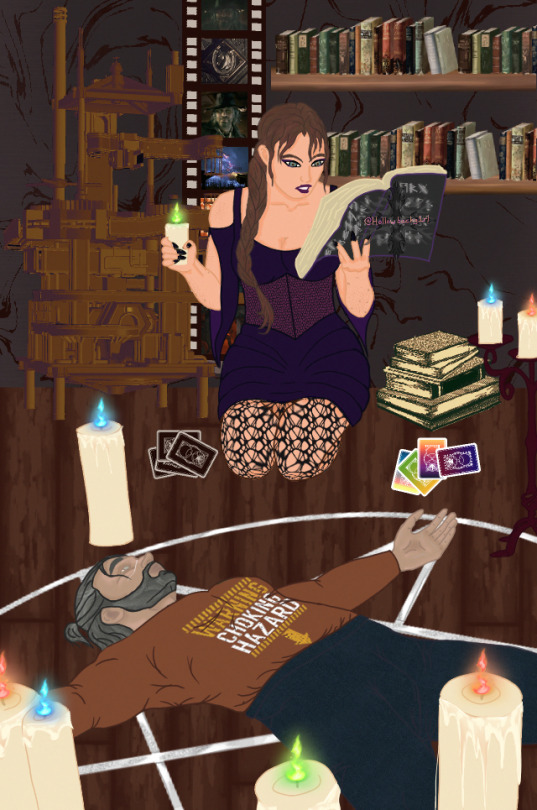
Quick Doodle examples
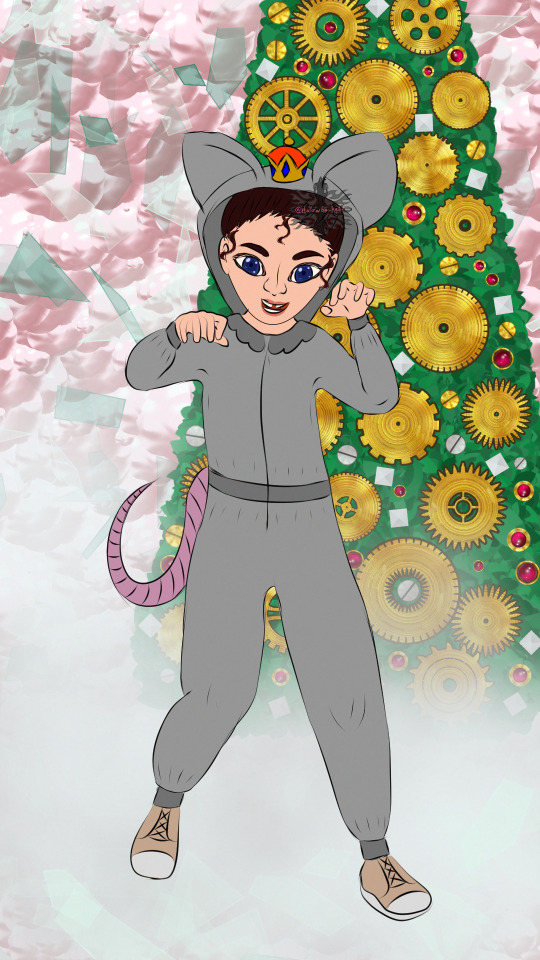
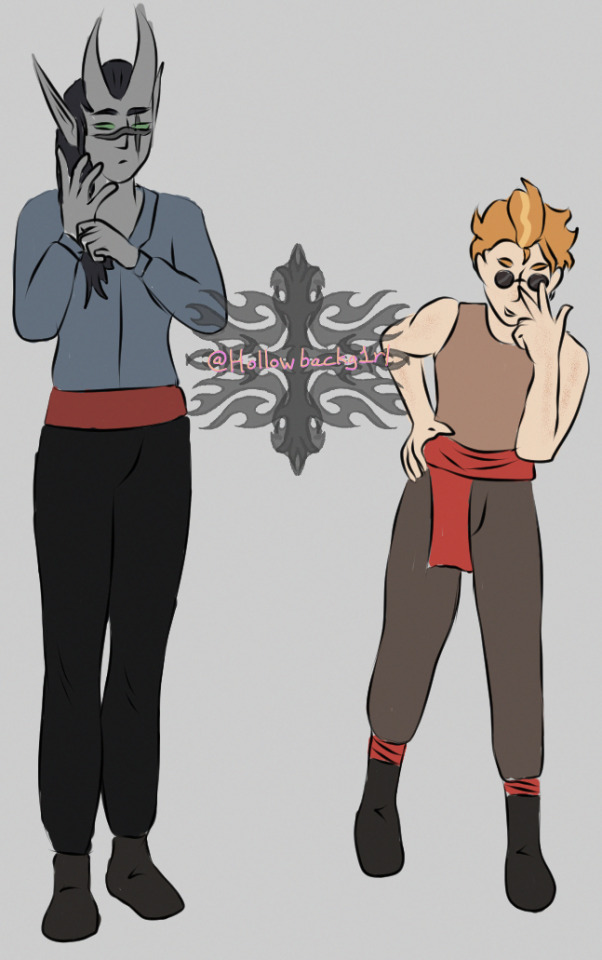
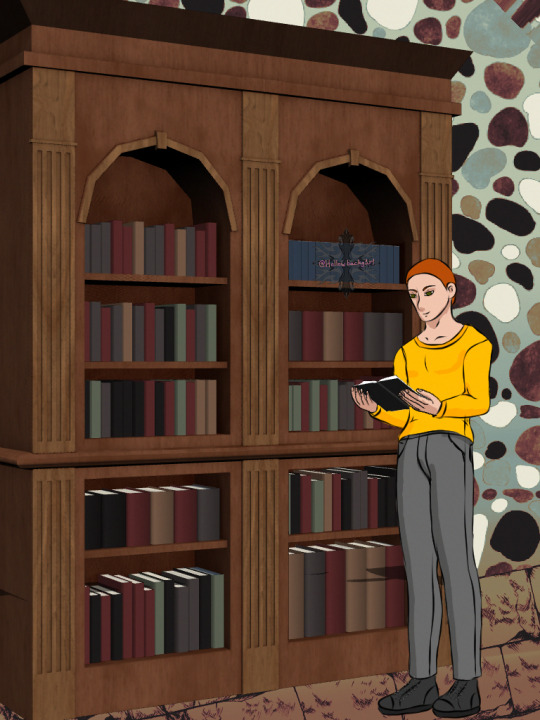
Weapon Bottle examples

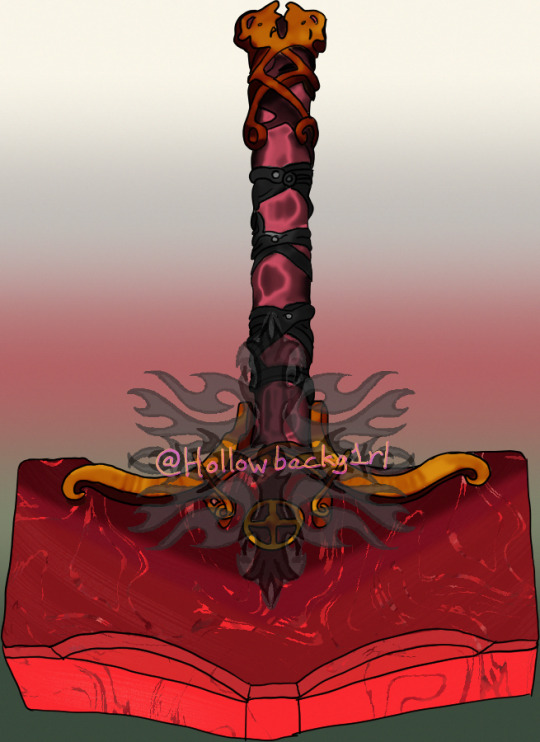

Portrait examples
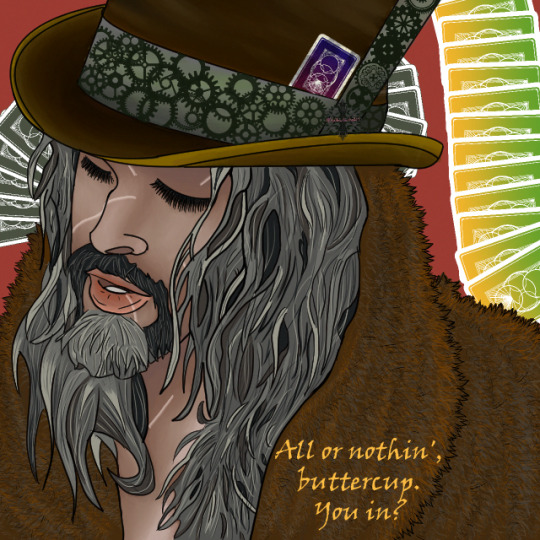

Full Body examples
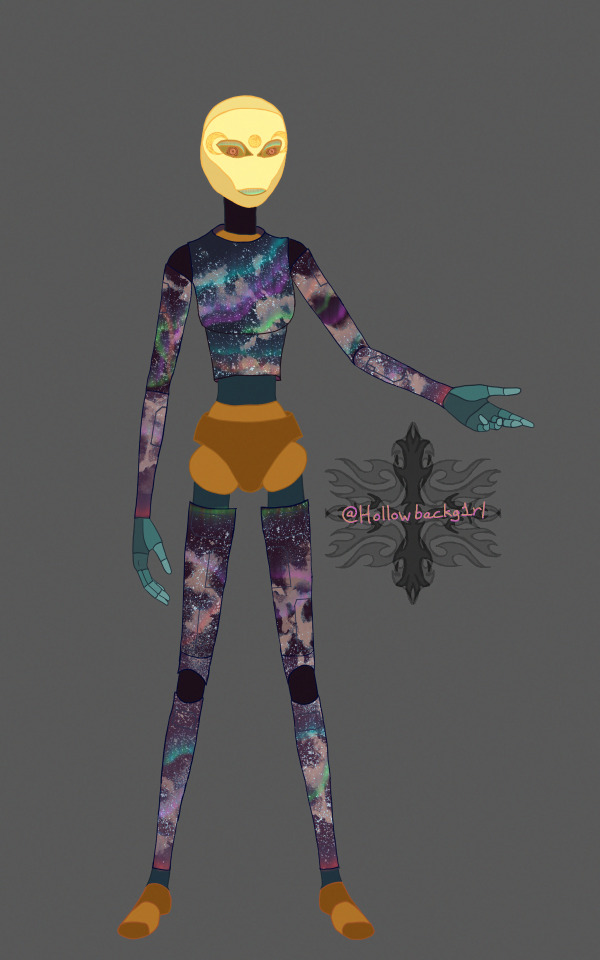
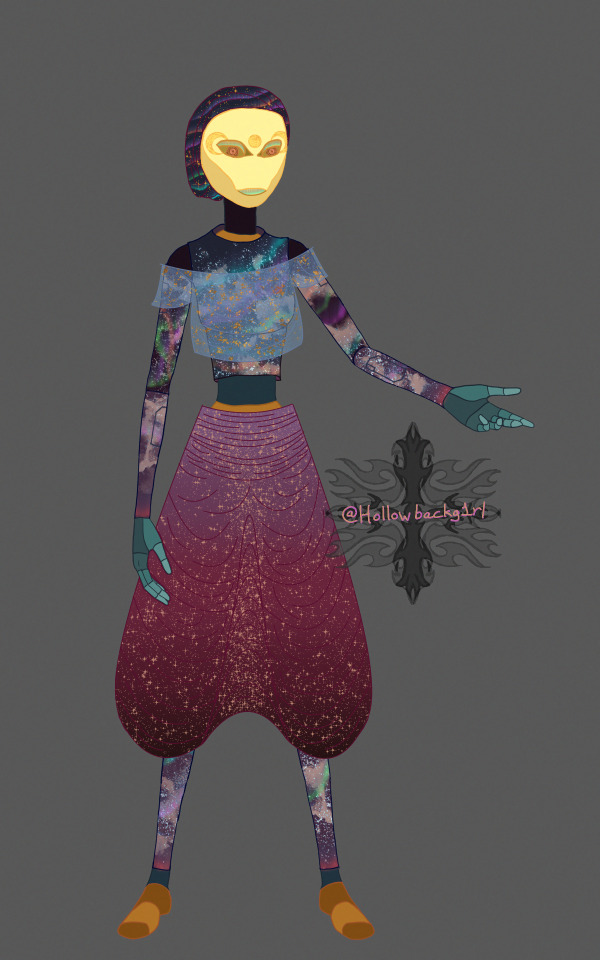
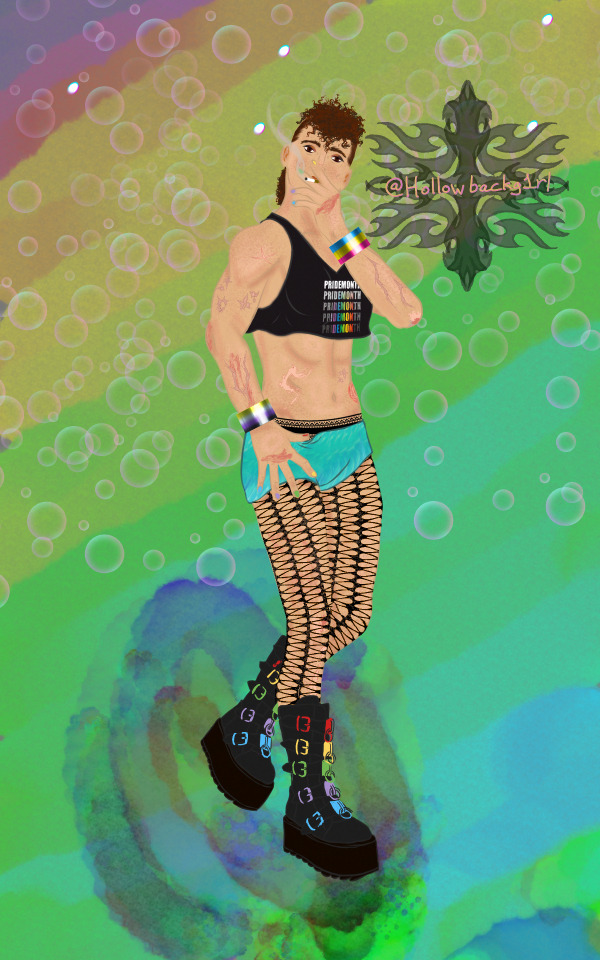

Character Sheet Example

#my artwork#artists on tumblr#art on tumblr#digital art#commisions open#art commisions#digital commisions#art community#art comms open#art commissions open#Hollow's art store
35 notes
·
View notes
Text

The Hell games will commence January 25! The games ill be conducted in the Wrath ring's amphitheater, and be broadcasted to all the various rings of Hell on select channels and streaming services.
This celebration is meant to showcase the raw, hedonistic carnage demons are known for in their entertainment! The Games will consist of five days of arena games with feasts, and various shows played in between matches! The matches will involve two opponents of similar merit locked in single combat with any weapon or fighting style of their choice. These battles have traditionally been to the death which will not change here, clemency may be given should the crowed be won over by the losing party but it should not be expected.
The matches will have various groups. These being Hellborn demons, sinners and angels, and nobles of both Heaven and Hell. Anyone from Hell and Heaven may attend the games, all expenditures shall be paid for by Satan directly. You are more then welcome to bring a plus one, or a plus fifty should you so choose. The arena will host any number, it hungers for bodies to fill its seats, and flesh and blood to fill its theatre.
All demons and angels are able to sign up to be combatants in the games, so long as there is an active pool of opponents to sink your blades into. We would not want to see St. Michael vs a lowly imp of course. Keep in mind you will have NO control over whom you fight. There will be no faction play, demons may fight angels, angels might fight angels, and goetia may fight goetia. The decisions shall be made based on schedules and what would make for the most entertainment.
Those amongst Hell's forces that prevail shall be rewarded as grand champion of the games, granted an estate to rival that of a goetic prince, their personal army, and all the currency they could ever need, as well as the respect and friendship of Hell's most ancient powers. Finally, all crimes committed shall be forever pardoned.
Those in Heaven shall receive a special prize should they win, one that is not at liberty to be made known just yet.
Applications for combatants are due the first of the coming month.
((OOC rules below))
You must like this post and reply to this post to let me know you intend on attending, just for the sake of keeping things organized for myself.
If you wish to fight please send me an ask telling me your muse's name, race, age, and their fighting style and weapons.
The games will start on 25th of Jan but they may go on longer if need be. Canonically they will be five days, depending on response times the irl time may be longer!
Anyone can fight! There are no rules barring anyone from joining!
You have to be okay with your muse dying! Not everyone who loses will die, and there will be more then one winner given the different classes! That said there is a possibility your muse could die! Please do not send in an application if you are not open to the possibility! Killing is sorta the point of the whole thing!
The fights should be plotted out between the two muns involved, though event coordinators (myself and potentially others) may offer help if needed. I shall talk to both parties before the fight actually starts to figure out how it will go.
The list of opponents will be posted the evening before the next day's games. Rules pertaining to fights may change as the roster grows, as well as how many different types of characters are involved. This list serves more as a foundation to add on later.
Feel free to ask me any questions!
Do not reblog this post as I will be adding to it if I feel I need to over the course of the next month. I am sure I most likely will.
35 notes
·
View notes
Text

@potensreginae presents…Relta’s Marvel Super Soldier AU/The Old Guard AU Verse V: My Baby’s Got A Gun
Born to Lady Ekaterina and Lord Douglass McLeod, rulers of a little known kingdom to the Northeast of what is now called “Russia” on June 14th, 1900 at 2:58PM yet was born in Manhattan, New York, USA to keep her from being kidnapped by anti-monarchists.
She was raised as an aristocrat of Old Money, yet they till were refugees by technicalities of their status. She made friends with the servant’s children, including taking one as a lover at age 18 despite her parents’ disapproval.
She has 3 younger half-siblings: Aislin, Alastair, and Madeline.
At age 29, Relta was choked to death by Madeline, who desired to have the crown once their parents stepped down in six years.
Relta was revived, however she’d been dead for three minutes. Not that modern medicine of 1929 could tell you (I don’t think), but she lacked brain damage despite the prolonged lack of
She served in WWI’s final year despite being heir to the throne of a small monarchy she planned to hand over to the people upon her coronation. She worked as a doctor due to her medical training being extensive as part of her royal upbringing
Relta’s parents and youngest sister, who had been 8.5 months pregnant, had been killed, leaving Relta as the only legitimate heir to the throne, and still the eldest and thus first choice in the type of monarchy she didn’t wish to rule.
Relta asked soldiers she was helping recover from injuries to teach her how to fight and shoot a gun, so she was taught how to by one in particular — [NPC INFO] Ilya Ivanov. The two also fell in love, marrying when he died, she revived him, and he became immortal seeming as well, and enchanted in all ways.
Relta and Ilya, sadly, were unable to have children when they moved back to Manhattan, NY, USA, to have a family. Their immortality seemed to be due to an injury to the reproductive system of Ilya during the war, where he had served as a Russian spy on the German front.
After the war, they settled down in Manhattan where her parents and siblings also lived, having a flat at the top of a skyscraper once they were perfected as hotels (if that hadn’t already happened). They were given diplomatic immunity and protections due to their royal status from their now obliterated kingdom.
Utilizes weapons, including guns modified to work with heavy tranquilizers, more so than utilizing her super strength in hand to hand combat. Otherwise, she is similar in fighting style to [Black Widow] and [The Winter Soldier]
Parting in the 2000s from each other and the Old Guard(if applicable), Relta headed to Hell’s Kitchen to help with the crime busting by superheroes by operating as a doctor for the angels and devils of Hell’s Kitchen.



* = The Old Guard AU Verse Only

#v: my baby���s got a gun#v: relta#muse: relta#verse info#verse info: my baby’s got a gun#marvel rp#mcu rp#comics rp#marvel 616 rp#mobile post#the old guard verse#the old guard rp#murder tw
8 notes
·
View notes
Text
Random non-modern scenario headcanon I have for the boys, basically in any situation modern weapons aren't applicable.
Alfred is usually guns and aircraft. So I would translate this to Alfred as a distance fighter, mostly bow and arrow, probably on horseback, ala Plains tribes such as Comanche. As opposed to European style, where I can still see archery, but the sword becomes a lot more likely because of course sword = hero.
Matthew is just way too suited to wetwork, mostly due to his stealth skills. (And Canadian trench raids.) He basically has an attack bear/dog as well. Blades, tomahawks, maybe war club? Regardless, much more likely to be on foot rather than horseback.
I think they'd both be reasonably good at hand-to-hand but nothing as amazing as some of the others (China, Korea, Japan, India, etc) Both also reasonably good at spear/lance/bo staff, but not outstandingly so.
I think that because Alfred comes off as more naturally aggressive, sometimes he gets cast in a more direct fighting position, but I think analyzing what modern weapons he uses really points to him as a ranged fighter. And putting him on horseback gives him the speed, mobility, and agility that matches his nature.
Close combat meanwhile requires patience and precision, skills I think Matthew is more inclined too. I always interpret him as more practical than Alfred, which in combat translates to a tendency to be more ruthless. If we're talking D&D, I'd be putting him more ranger than a fighter, but I definitely see him close-range.
Both of them would be likely to incorporate animals into their combat style however.
19 notes
·
View notes
Note
Dual, 10 & 11 for the Edgy/Misc OC ask game
Edgy/misc OC ask meme
Thanks so much for the ask! <3
10. What's an AU that would be interesting to explore with your OC?
Dual was originally meant for the Hellaverse, but I have since stuck them in Steven Universe and Soul Eater!
I talk about SU!Dual here, but the TLDR is that they’re an offcolor.
In the Soul Eater AU, Dual’s probably still gonna be going by Ash. They’re a miester; specifically Raze’s miester!
@i-write-sin-not-tragedy and I have also done this fun thing where we’re both throwing our OCs in a jar together and shaking them. I’m not sure if that counts as an AU or not, though, because honestly I’m having so much fun it’s hard to imagine a version of Dual’s world where Cloud isn’t at least just hanging out in the background lol.
Second question under the cut for length:
11. What is your OC's weapon of choice? Have they ever actually used it?
I was so tempted to wait to answer this until I could draw Dual’s weapon because I wanna show it off, but I also really wanna answer the rest of the ask, so the drawing will have to wait.
In every universe besides the Soul Eater one (where Raze is their weapon) Dual’s weapon of choice is a sword! Specifically a very impractical sword that operates on cartoon logic. Or video game logic, because I got the idea from Elder Scrolls.
My partner mentioned the Bipolar Blade, around the same time I was trying to pick Dual’s weapon and I said, “I need you to show me what that is right now, because I cannot think of a more fitting weapon name for my bipolar bisexual bigender OC.”
The actual TES Bipolar Blade is honestly a bit disappointing in its design (to me, at least) but the gist of it (sword made up of two different styles, one for each half of the blade) inspired Dual’s weapon!
Dual’s own sword is divided between water and fire motifs, warm colors and cool colors, smooth and serrated. It’s very clearly just 2 different swords.
Anyone who knows anything about swords would probably have A LOT to say about how wrong it is, but again, it’s a cartoon. I will be taking advantage of the medium to give Dual an unrealistic but super cool weapon.
As to whether or not Dual’s ever used the damn thing… well, they only discover its existence like partway through the series. In all applicable AUs.
In the Hellaverse, the sword is Dual’s “thing,” like Alastor’s mic or Angel’s guns. It’s connected to them/their powers, and they can store it in hammer-space and summon it when needed. They just uh. Don’t know that they can summon it until Raze mentions the its absence.
(Because I’ve decided every single Sinner has a “thing,” that works on the same logic even if we haven’t had that confirmed. There are a few more examples where it’s at least suggested: Husk’s cards, Niffty’s needle, Cherri’s bombs.)
And Raze knows this—knows that Dual must have a weapon even if they haven’t been able to access it yet—and decides to poke around.
In the Steven Universe AU, they kinda assumed that they couldn’t summon their weapon by nature of being a gen 2 offcolor (two things which interfere with gem powers), but is eventually able to gain access to it!
In both cases, once Dual knows about and is able to summon their sword, they will use it. There are some big fights planned >:3c
#fanby answers#moonrose91#and they were mutuals#i write sin not tragedy#(<- mentioned; also mutuals)#fanby: ash waters | dual#hv chaggiedaze#su chaggiedaze#se chaggiedaze
4 notes
·
View notes
Text
More fic stuffs cause I am bored - This time fighting focus once more
Gladiator!Liochant is a better fighter than any member of the main cast by a solid margin, but only has a 50% chance of winning against them one-on-one in a spar, and that's with some grace.
I have gone over and over on how the fighting style Liochant was taught in Tu'la is not that applicable in Ru'aun. Fighting against heavy armor is difficult when coming from a light armor (if any) country is essentially the point, but even out of armor, each individual poses a problem.
Katelyn is both heavily armored AND fast. She is strong, so there is no real way to overpower her with Garroth being much the same. He is a heavily armored brick wall who uses a big sword and shield, so the only way to beat him is to get close, if you even can. Aaron is much the same way, just without the protective layer, but he is more observant.
Aphmau, while not that big of a fighter, still poses a challenge. She is small and sturdy and impossible to beat, like a boar. Travis is a difficult fight because he is incredibly observant, discerning shape shifting demons your entire life will do that to yeah. Laurance and any real shadow knight, for that matter, are all incredibly difficult fights because once you get them angry, the only way to win is to kill them.
On the flip side though, Liochant would have a better chance at killing the main cast than he would beating them in a spar. Collectively, a 60-75% chance, depending on the individual. While he is not suited for sparing the others, killing them is another story and something he is trained for.
He wouldn't be able to kill Aphmau, full stop, and his other hardest opponent would probably be Aaron, just by the nature of it. Shortly followed by Travis because demon Warlock bullcrud, but I don't think it would be impossible for him to kill the rest .
Laurance, his easiest. Liochant grew up in a religion dedicated to defeating shadow knights. Unfortunately, Laurance stands no chance. Katelyn would be the second easiest, solely on the fact that her clawed weapons are very cat, very Tu'la. A weapon he is familiar with, so being able to beat it to a kill isn't hard. Garroth would be very difficult because of his shield and relic.
Liochant would only really be able to kill Garroth because Liochant is from a different country with a different fighting style, and Garroth doesn't do well with surprises.
7 notes
·
View notes
Note
What do you feel about Shouto's current moveset and how do you think it can be improved? How about your thoughts on my ideas?: Heat generating ice crystal constructs, better malleability with his ice and flames (Geten's whole thing and Endeavor's spear and wings), perhaps with Phosphor he can create cold fire constructs like swords and bows? Maybe a martial art like Kung Fu which focuses on Energy and Patience to help him with QCC and with his hands being elementally boosted?
How do you feel about how Shouto utilizes his quirk? Some say he uses it too plainly/straightforward. I'm inclined to agree cause comparing him to his "Rivals" Bakugo and Deku, he seems to use it the same every time, and it feels like it goes into his favor cause while he doesn't have a fighting style, close quarters option or unique and creative use cases relative to Bakugo and Deku, he has excellent planning, wits and the quirk by itself being OP to all hell, what do you think though?
With Todoroki's personality, do you think he'll ever reach the Blue flames Dabi achieved and his usage of Phosphor? Stronger flames but no becoming a bomb though. Or do you think after everything he's gone through he'll still favor freezing over fire?
So I am willing to talk about Shoto's potential applications, but I want to talk about these together for the time being since I believe these will set up the foundations for later.
Do I think Shoto could be using his power better? To a degree. He could be using his abilities in more unique and interesting ways, but I think that he's using them pretty darn well as they are. To me, Shoto is someone who has effectively two abilities but can't exactly reach the heights of either one. He can achieve similar feats to characters like Enji and Geten, such as flying with fire or being able to form crude ice creations, but he can't do it with the same kind of finesse, scale, or power that the others have. This could be because he effectively has to train two powers and can't focus on either, but considering he's been training it most of his life, I believe it's just something he can't do. So I don't think he could do a lot of that. However, he doesn't really need it. "Half Cold Half Hot" is one of the strongest Quirks in the series. One of it's greatest advantages is the sheer range and control he can exercise with his elements. It's simple, but powerful. He doesn't need many fancy tricks to make it work. Shoto's like a caster in a video game. He does these massive attacks that clear the area and deal lots of damage from far away. Why bother trying to apply martial arts or form cool weapons when he can just freeze someone in place or nuke them with a fireball if they get close to him?
10 notes
·
View notes
Text
So tonight I practiced, among many other things, managing binds. I was drilling some techniques for controlling blades with a Noble Gentleman when I noticed a particular motion he made. This Gentleman has a preference, I have found, for the Spanish techniques wherein one does not lunge directly but rather maneuvers around the opponent's body. Of particular note was a technique in which he closed, gained control of my blade, and then disengaged.
I have, as I believe I have discussed before, a shorter blade. Mine is approximately 36 inches, I believe? It is sufficiently short that each person I have fought has felt the need to inform me of the disparity in our blades. As such, controlling measure has been a challenge as I have developed my skill. Of late, I have taken to relying on passing steps to very quickly close the distance and enable a very aggressive style. This is where my difficult starts. I close in, force a bind, and am unable to successfully disengage to strike. This makes fights last longer, so I am no longer dying immediately, but has not yet translated into better outcomes. I'm still all losses and doubles.
But when I bound with this Noble Gentleman and he readied his strike, I noticed a subtle motion of his feet. He disengaged by way of a passing step backwards, which naturally freed his blade and cleared him of the line while his offhand remained steady to control my weapon.
I think this is the natural evolution of my technique. I am already practicing my passing steps (of which I am quickly growing very fond) and this is simply a new application of that same technique. Once I close the gap to force a bind, I can then rotate back and out to free my blade and strike.
Of course, practicing the motion in drills is not the same as practicing in a full speed bout. I will report back after Wednesday practice with how well this realization has translated into actual technique.
6 notes
·
View notes
Text
assorted things you can do in pathfinder 2e that I just love
Do note that the thing that matters most to me is that these are not things that you have to ask GM permission for, or come up with on your own, and count yourself lucky if your GM is cool enough to allow it without dropping massive penalties on you for no benefit (and from the GM side, you can let your players do this confident in the knowledge the well-designed game is intending to enable this behavior)
As a specific variant of Gunslinger, toss up a one handed melee weapon (let's say an axe because it's so fucking cool but it can be whatever) and shoot it with your gun, LAUNCHING IT INTO AN ENEMY AND THEREBY COMBINING THE DAMAGE OF BOTH AXE AND GUN INTO ONE HIT FOR THE PURPOSES OF OVERCOMING DAMAGE MITIGATION. AND if it hits, the axe AUTOMATICALLY bounces off them and you just catch it. You just catch it! There's no roll, there's no GM fiat to let you do it, you just do! That's PART OF THE ABILITY!
THAT DOESN'T COST A HYPER LIMITED RESOURCE YOU CAN JUST DO IT
As a monk, any monk, every monk, at level 1 and any level after, FROM THE MOMENT YOU PUT 'MONK' ON THAT CHARACTER SHEET, you can flurry of blows EVERY TURN, FOREVER, and there is FUNCTIONALLY ZERO DOWNSIDE. Because you're a MONK. That's what you DO.
Speaking of monks, are YOU bummed out by falling behind other martials because you can't have cool magic weapons and still fight unarmed, and magic monk-specific weapons are rare? Well in PF2e, you can just wrap some fucking shit around your hand, enchant it, and BAM, you have access to the same magic enchantments any other martial gets.
Kineticist is a class that ten thousand broken homebrews exist to try to achieve across various other systems and it is both balanced with its peers and FUCKING AWESOME
Inventor and Alchemist are ACTUAL CLASSES with ACTUAL MECHANICS that ACTUALLY DIFFER from any other class, and you aren't just casting a spell but flavor it differently. If I want to be a crazed scientist making bizarre machines to do various things, I don't have to follow the rules of Magic Missile to make it happen. I HAVE MY OWN SPECIAL TOYS THAT MAKE ME DIFFERENT FROM A WIZARD!
Speaking of wizards, WOW! They are allowed to be super useful and super cool and super fun WITHOUT being the ur-mage that does everything every other mage does But Better.
I have off the cuff come up with more than 40 different broad strokes ideas for a character and have been blown away by the fact I can go into pathbuilder (free, LEGALLY FREE, character building application that does not have to beg the company that makes the game for permission to exist and has EVERYTHING, INCLUDING ITS DESCRIPTIONS AND RULES) and make a character all the way to level 20 that perfectly encapsulates my concept and does a GOOD JOB OF IT
Godbreaker. Just. Godbreaker.
Did you know you can cast a spell summon a fucking giant monster whose existence is meant to herald in the apocalypse that gets pissed when it realizes this is not in fact the apocalypse, and charges through a portal that appears 200 feet away, completely wrecking everything between it and the portal?
THAT'S RIGHT! FINAL FANTASY STYLE FUCKING SUMMONS, WITH HILARIOUS JUSTIFICATIONS
IN THE GAME, AS A SPELL, NO HOMEBREW, NO FIDDLING WITH NUMBERS
GODZILLA IS HERE! MOTHRA IS HERE! GHIDORAH IS HERE!
KAIJU HUNTER IS NOT JUST A CHARACTER CONCEPT YOU CAN COME UP WITH THERE ARE A TON OF RULES THERE TO SUPPORT YOU IT'S A FUCKING ARCHETYPE
Did you know that Human Fighter can be a REALLY COOL build? It isn't just the generic boring made-fun-of "of course the new player made this, go roll a d20 every turn while the adults play" option? Motherfucker you can make TREVOR BELMONT and be EFFECTIVE and STRONG!
there is a country that is just Pirateville Tortugaland and you can be from there and there are LOTS OF WAYS TO BUILD A CHARACTER TO FIT
YOU CAN BE A CLERIC OF THE PIRATE QUEEN WHO IS ALSO A GODDESS
YOU ARE ALMOST CERTAINLY A PIRATE CAPTAIN IF YOU ARE
HER HERALD IS HER FUCKING PIRATE SHIP SHE RIDES IN ON WHEN SHE RAIDS OTHER GODS
SHE IS NOT EVEN LIKE TOP 20 MOST IMPORTANT DEITIES IN THIS SETTING SHE'S JUST LIKE THAT THAT'S JUST. THAT'S JUST WHAT DEITIES ARE!!!!!
Vampire is a FUCKING ARCHETYPE. No more "oh you became a vampire? Well you're an NPC now. Yup. Sorry!" FUCK THAT VAMP OUT
WEREWOLF TOO, WHY NOT!
They added an archetype that lets you be a mad scientist and it's the SICKEST SHIT
The flavor of every god damned thing I've found is immaculate
Did you know you can get mantis themed armor that lets you store weapons in the sleeves? YOU CAN BE A KAMEN RIDER?
"Surely," you say. "Surely 'Kamen Rider' is like level 20 armor, and it sucks statistically."
No, no, no, my friend! you are simply jaded from other systems I will not name.
LEVEL. FUCKING. TWO.
Yes there is an insane version for level 18 but
LEVEL.
TWO.
HOOOOOOOOOLY FUCK THIS GAME IS SO COOL GUYS
6 notes
·
View notes
Text
Cape Cod, Massachusetts.
This workshop series aims to provide an in-depth exploration of Northern Shaolin Kung Fu, its philosophy, training stages, and unique characteristics. Participants will gain insights from Master Kisu's extensive experience and the rich history of the Northern Shaolin style.
The training of Northern Shaolim follows the process of natural bodily development. That is also the reason why we felt that the Northern Shaolim style is one of the best system for training kids and young people.
The First stage of Northern Shaolim training emphasizes the development of the joints of the individual. In this stage, whether it be the exercise routines or the fighting forms, the demand on the movements are wide and long circular movements executed with fluidity rather than strength.
The purpose is to widen the range and mobility of all the joints including neck, shoulder, waist,hip, wrist, ankle etc. At this stage, the movements or techniques have little actual combat applications, but its movements are generally very graceful and pleasing to watch. This is great exercise for young kids for their growth.
One thing to point out though, most Northern Shaolim practitioners stop at this stage thinking this is the aim or the final form of Northern Shaolim.
What are the essential characteristics that make the Northern Shaolim Style unique ?
Most styles of martial arts emphasizes specific characteristics, techniques, philosophies, theories etc.
What makes the Northern Shaolim Style unique is that its an overall encompassing style that is well rounded and covers all aspects of training and techniques.
The styles curriculum covers techniques for all fighting ranges (long, medium, and short). It covers the applications of all parts of the body as weapons and tools without biasing on any particular means such as kicking or grappling.
Since most Kung Fu styles are developed to enhance the inventor's specialty or cover for his weaknesses, (examples are Wing Chun, Pray Mantis, etc.), the most difficult aspects of martial arts are not covered by many styles.
These aspects are speed, mobility, agility, power, and long fighting range. Just because the Northern Shaolin style is broad and covered these aspects fully, it actually became famous for these specialties.
From my personal insight, the uniqueness of the Northern Shaolim style is the natural body mechanics, the foot work, the arrow like forward attack techniques, the feather like retreat skills, and the broad variety of hand and kicking techniques.
We will be sharing Northern Shaolim Essential foundation techniques.
The Northern Shaolin style of Kung Fu as made famous by Grand Master Kuo Yu Chang is a cumulative set of Kung Fu techniques, both northern and southern styles, choreographed by the Grand Master into a curriculum that he taught both in the Nam Jing Kung Fu Institute and his Canton Kung Fu institute. His curriculum increased throughout his teaching years to include techniques of many styles. The Grand Master, being highly skilled in the Northern style of Kung Fu, emphasized the Northern style of Shaolin Kung Fu in his teachings.
Since most of the stories of martial art origins, including that of the Northern Shaolin style, are passed down by word of mouth, we can treat all of this as more a part of a legend than facts.
The Northern Shaolim style of kung fu is one of the most prominent traditional Northern styles of Chinese martial arts. The Northern styles of Gung-fu generally emphasize long range techniques, quick advances and retreats, wide stances, kicking and leaping techniques, whirling circular blocks, quickness, agility, and aggressive attacks.
The system teaches empty-hand techniques and weaponry through predetermined combinations, routines, or movement of sets.
The students learn the basics by practicing the routines until the movements in the routines can be executed naturally based on instinct. Then, two or multiple man sets are practiced to train responses and applications of techniques learned from the sets. The practice sets/routines are not only practical in applications but are also graceful and artistic in nature. The fluidness of the movements combined with acrobatic techniques are trademarks of the Northern Shaolim Kung-Fu sets.
Northern Shaolin workshop series
With Sifu Kisu
Fifth generation disciple of Hui Clan NSKFA
Forms, Theory, Applications, Weapons
More details to follow…
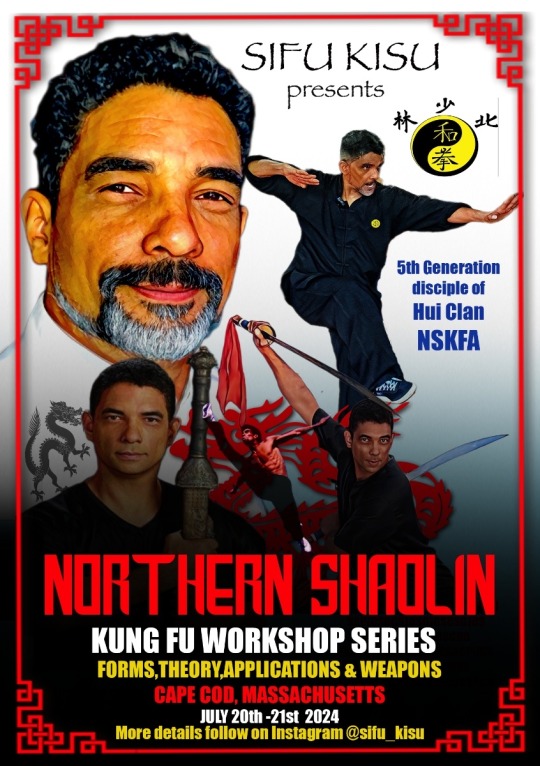
19 notes
·
View notes
Text
A (Hopefully) Helpful Guide to What in "Hell" is Bad?
Part 4 - Unit Types, Elements, Battle Boards & Battle Tips
Last Updated: Oct 31, 2023
I have a mild love of documentation (okay, it’s a problem) and I find it fun— so here we go! I’ve hopefully written out most of the options you’ll encounter while playing, as I know it’s been a confusing start with the game coming out in the state that it did.
And let’s be real here, most gacha-style games can feel overwhelming at first, especially if you’re new to them overall. It happens, and with all the questions I’ve seen floating about, I wanted to maybe help someone out, as well as have some fun. Or this’ll flop, either way, still fun.
There will absolutely be things I’ve missed, or glossed over— or even gotten wrong— so feel free to ask about anything, tell me things, or correct me.
For full transparency— I have spent money on this game, but I have not “whaled” whatsoever. I wanted to test certain things, and I have a strong sense of curiousity.
Looking for another part of the game? Check out the other parts:
Part 1 - General Overview, Achievements and Contracts
Part 2 - My Devils, Levelling, Skills and Artifacts
Part 3 - Chapters, Levels and Dark Sanctuary
Part 4 - You Are Here!
Part 5 - Shop, Secret Shop, Inventory and Management
Part 6 - Secret Club (Adore), Secret Club (Unholy Board), Hell-Oh! Talk
Now, let's keep going!
Battle - Unit Types
We talked about it before when looking at the "My Devil" screen (very briefly), but each devil has it's own style of fighting and element applicable to it.
For all units, always look at their normal attacks and ultimates (passives as well if applicable) before levelling them or putting them on the field. You’d be surprised what some of them can do.
Types of Units
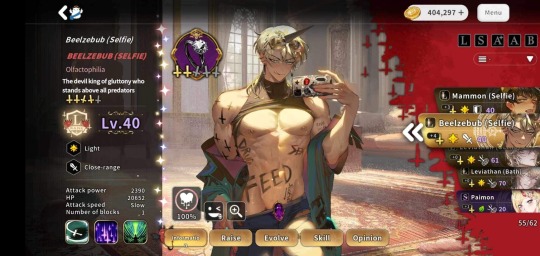
Defense
Devils: Mammon (Selfie) (L), Bimet (S), Valefor (A+), Eligos (A+), Undertaker (A), Caine (A), John Cena (B), Booker T (B), Rob Van Dam (B),
These units are the bulky boys of the game-- the best example being Mammon (Selfie).
These units are intended for longevity on the battlefield, being bulkier than other units with their health
They also stop multiple enemies-- typically 3 at once, whereas other units can usually only stop one
They have a small range-- usually 3x3
Keep an eye on their health— bulk doesn’t mean invulnerable, especially if you’re fighting stronger enemies
Close-Range
Devils: Beelzebub (Selfie) (L), Naberius (S), Amon (S), Bael (S), Dantalian (S), Stolas (A+), Gusion (A+), Bathin (A+), Phenix (A+), Renové (A+), Toto (A), Max (A), Bella (A), Leo (A), Molly (A), Gaejuki (A), Harumon (A), Bob Marley (B), Lucy (B), Bailey (B), Urupapa (B),
These are DPS devils, attack-based units that require the enemy to be up close and personal.
Depending on the devil, can be a little squishy, so it's best to let them hide behind defense devils, or to the side, if you're a little under leveled
Small range, usually 3x3 but can be a little larger
Usually these can only stop 1 enemy at a time
Marksman
Devils: Leviathan (Selfie) (L), Leviathan (Bath) (L), Satan (Selfie) (L), Minhyeok (S), Paimon (S), Sitri (S), Leraye (S), Belial (S), Foras (S), Zagan (A+), Ppyong (A+), Astaroth (A+), Barbatos (A+), Glasyalabolas (A+), Ppang (A), Ppam (A), Ppungppung (A), Ppolppol (A), Ppyongppyong (A), Red Ragnarok (B), Nightslave (B), Fishball (B), Darkness Weapon (B), Oni (B)
The long-range units! These boys will pick away at the enemies from a distance. Very squishy— keep them safe.
Their range varies more widely than the other types in the game, but are always good to have in the back or to the side of a lineup
Some like Belial and Leraye have very long ranges, while some like the Leviathans are a bit shorter— make sure to look at their respective ranges when you’re selecting them for the field!
I said it above, but keep them out of harms way, as they can be taken out with relative ease— especially if they’re under leveled
Healer
Devils: Marbas (S), Morax (A+), Buer (A+)
These are the boys’ who’ll help keep you alive— but there’s certain ways to use them to make them actually valuable. There’s limitations to what they can do, and often damage can outweigh the minimal health they give without finding ways to utilize them.
As you can see, there aren’t many healers in the game at all yet, and they vary pretty widely in what they can do
In many cases, you probably won’t use your healers… the numbers they give back to you are quite minimal compared to the damage enemies do— but they’re not entirely useless
If you’re pacing the enemies and allowing your healers time to do their work, they can be pretty beneficial
Be sure to look at their range of attacks, too— and keep in mind that Marbas cannot attack at all! (In exchange though he constantly heals in a small area that moves with him, and his ult that releases it charges very quickly and you need only use it once)
Battle - Elements
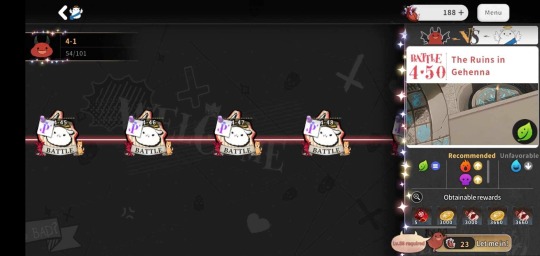
I’ll be very honest here— I don’t pay that much mind to these, and usually battles go pretty smoothly. That said, my team is mostly the Light element, so that might have something to do with it.
But, here we go! Good old fashioned strengths and weaknesses— think Pokémon, but incredibly simplified.
Each element has a weakness and a strength— pitting a weaker element against the stronger means your devils are gonna be in for a time.
What are the elements in WHB?
The available elements currently are: Fire, Water, Grass, Light & Dark(?)
There are currently no units available for “Dark” so I can’t double check— I’ll update that when I can or if someone can let me know what it’s meant to be called. Regardless of it’s name, we can still take a look at what it does!
It’s pretty basic—
Water is strong against Fire
Fire is strong against Grass
Grass is strong against Water
The edge cases are Light and “Dark”— as they are strong against one another, and neutral against the other elements.
I’d love to say if you’re having a hard time in a level just try changing your elemental lineup, but in the early game that can be difficult. Eventually level 20s will be too squishy to survive or deal enough damage to be useful, and promoting them is costly. That said— you can get through a good chunk of the game with all level 20s with one level 40.
Battle - Battle Boards
There is a wide array of gridded “boards” that your battles will take place on— all with their own limitations and paths, so I won’t cover every variation here. However these can be divided into three overall “categories.”
Story Battles
Story Boss Monster Battles
Dark Sanctuary Battles
They all have similarities, though, so lets go over the basics. When you enter a battle, you’ll be shown the map layout and a list of your devils along the left side— you can select six of these devils to go to war for you. You can choose to only see certain rarities or just supports during your selection, but there’s no other ways to sort them— so you’ll need to scroll through each time.

Note: To see your stats like I am in the screenshot above, just press and hold on the devil you want to see the details of!
What can you view right off the bat?
Stage Number - The name/number of the stage you’re currently on (4-50, indicating I’m in Chapter 4 Level 50)
Angel Wing Icon - How many angels you’re dealing with in this stage. Each level will vary (39 in this case)
Heart Icon - That’s that big red heart’s on the left’s health — that indicates you! If three angels touch this, you lose
Paw Print Icon - This indicates how many times you may move your devils once the level has begun — you don’t need to worry about it during the setup phase seen above, but keep an eye on it once the battle starts and you begin to move around as needed!
x1 / x2 Icon - Your current battle speed— angels move slow, and on levels your confident speeding them up is definitely nice. Just tap it to do so. Tap it again to return to x1, if you’re feeling overwhelmed
Pause Icon - Pause the level!
Door Icon - Leave the level
Devil Select List - A list of all your devils (press and hold to see details), drag and drop up to six of them to fight for you! You can only narrow down by rarity and support, so you’ll need to scroll each time
Let’s Roll Button - Start the level! You’ll be warned if your devil count is below six, but you can still start if you want to
Okay, wait, huh? What do I do?
Basically, you’re going to drag and drop six of your devils onto the grid— sometimes, a square may not be allowed, and it won’t let you, so you’ll need to select another one (this can be frustrating).
If you’ve beaten the level once, it’ll remember your team for the next time.
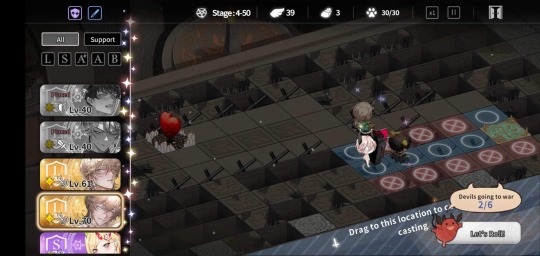
As you drag your devils onto the board, you’ll be shown their range of attack— keep that in mind! Place your units carefully to support one another, and keeping your squishy units out of harm’s way.
If you change your mind about a devil, drag them down to the blue area in the lower right, and it will take them off.
Okay, good to know. What should I expect from these maps?
That depends on what board you’re on, and differs per level. Let’s delve into those three board “types” I mentioned earlier.
Story Battles

These are the battles you’ll be undertaking between actual story. The maps vary widely, but tend to be the same for at least a few in a row before changing again.
Keep an eye on where the spawn points are— remember, enemies come in waves, and not all at once
Boss Monster Battles
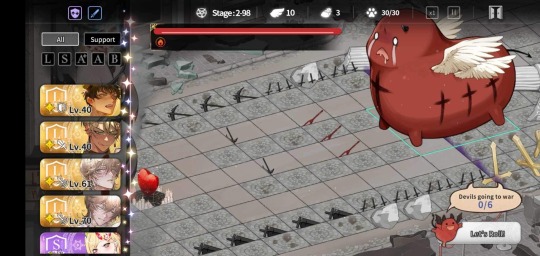
Note: The bosses can obscure spawn points for small enemies! Be aware that what you see may not be all of it and don’t be surprised if suddenly an enemy comes out from under or beside it.
Welcome to the big boys— these stages have large enemies just like the Dark Sanctuary, with big AOE or wide-scale attacks (usually). Alongside them will be normal enemies, but in exchange for the big-bad, you won’t have to deal with the hoards you usually see in the regular levels.
Dark Sanctuary Battles
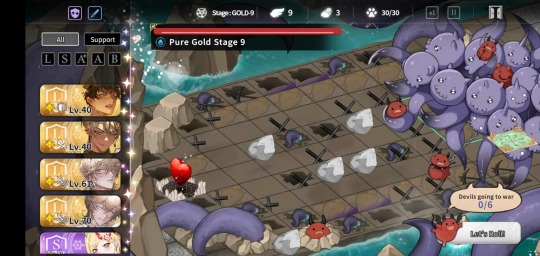
Note: Just like Boss Monsters— these guys can obscure spawn points. Be mindful! Actually, they can be worse for it (I mean look at that tentacled behemoth)!
These are very similar to Boss Monster Stages— but this is all that Dark Sanctuary is. At lower levels it will just be the boss monster, but as you go up in difficulty it will add in the normal enemies as well— be careful!
What happens if I lose? Or if I want to quit?
Nothing! As of right now, there’s no real repercussions. If you lose or quit a level, you don’t even lose AP— so try all you like.
What about enemies? Anything to say about them?
I’m not going to breakdown each individual enemy (unless you guys want me to, in which I can create a new part, I guess), but here’s a few things to keep in mind.
Each enemy model has three variations: white, red and black, and the colours represent (I believe anyway) the difficulty of the creature
Each enemy has a range! Some, like the slime-like-blobs, need to be right on your devil to do damage, but many have a further range and they can be difficult to deal with (especially with the moving devils glitch that’s currently in the game)
They tend to come out in batches of certain enemy types — i.e. if you see one slime, chances are there’s another one or two behind it (or more), before the enemy type will switch again from that spawn point (it’s not a set in stone rule, though!)
Enemies spawn spaced out from one another, usually when the one on the field is 3-4 squares away from the spawn point, but this varies
Enemies have elements, too— hence the triangle of weaknesses we talked about earlier
Battle - Ultimates, Tips & Tricks
Let’s start at square one - Ultimates
Each devil has an ultimate move that takes time to be able to use— it will build through the battle beside their icon at the bottom—the purple bar beside their health— and the icon will glow when they’re fully charged up.
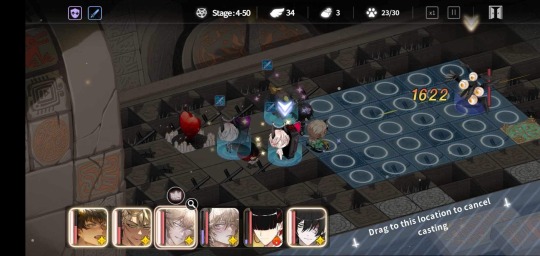
When you want to use them, tap their icon— this will slow time for you so you can aim— and you can see a crown above their icon along with a magnifying glass. The magnifying glass will explain what their ultimate will do if you don’t already know— but to use their ult you tap and hold on the crown, then drag it onto the battlefield to see its range of effect. Let go to use it!
The enemies in range will be brighter than those out of range. Once you’ve let go, you’ll see a little animation and hear a voice line before the ultimate hits the field!

Note: Don’t actually use Leviathan’s ult on a single enemy if you can help it— stun it, build them up by keeping a distance. He’s got such a wide range you may as well take out as many as you can.
You can cancel using your ultimate by dragging it down to the blue area in the bottom right!
Battle - Tips & Tricks
Okay, here’s a couple things I’ve found help, or that I tend to use while I’m playing— hopefully they help! Some are probably obvious, but you never know.
Don’t stress about ‘Required Levels’ that the stages tell you— often you can with with lower levelled units despite the recommendation, play around with placement and see what happens
Don’t spam your ultimates as soon as you get them! Especially with units that stun (Belial and Mammon for example)— it can be pivotal in a harder fight to give yourself a moment to breathe
I actually can’t recommend stunning enemies enough, it helps so much with grouping up enemies and giving your units time to recover health if you want to go that route
Try to aim to hit as many enemies as possible per ultimate (if applicable) — I usually aim to have 3 or 4 enemies within range at least before using ultimates such as Leviathan’s (stun is also good for this, keeping them grouped up)
If you want to bring a healer, I recommend Marbas or Morax over Buer— but honestly bring who you like— but keep in mind you NEED to give your devils space between enemies for them to be helpful at all— healers are SLOW at healing, and give MINIMAL health back so if you’re swarmed with enemies, they just can’t keep up
I actually use Marbas, despite that he can’t attack. I rotate who’s in his AoE and move him as needed flipping who’s under fire and allowing the others to recover with his constant healing
Crowd control ultimates are beyond helpful— getting rid of large amounts at once can save your battle if you’re in a tougher level
Don’t be right on a spawn point if you can help it (sometimes it’s just not easy to avoid), give your range units time to pick away at health bars before they reach your close range/defence units to save them from losing too much health
Ranged enemies are ANNOYING— get rid of them asap. They probably won’t be as bad when we can freely move our units without risk of breaking the level (see below)
This may eventually be patched out, but right now after the battle begins you can often move your units to spaces that were designated as unavailable during the devil selection— and I utilize it as much as I can— being able to place units wherever is incredibly helpful
IMPORTANT! Be extremely careful right now when moving your characters around— there’s currently a glitch that causes them not to move properly, and leave an invisible phantom of themselves where they once were.
This causes issues like:
Accidentally swapping your characters when you move one to where another once was, eating up your limited movements to fix it
If your units DIE while in this state, the enemies will glitch out and soft lock the level, forcing you to start it over
In Part 5 we’ll over the Shop, Secret Shop, Inventory and Management!
#whb#what in hell is bad#whb prettybusy#prettybusy what in “hell” is bad?#whb help#whb guide#~Astro Guides
28 notes
·
View notes
Text
Fanfic Idea
So as I understand it, bnha is just our world if 200 yrs ago superpowers came into being, right? So what if a female Izuku found the RWBY series and got the idea to try to emulate the different fighting styles and weapons displayed.
Just imagine an eight yr old izuku learning how to build support gear just to make Rubys scyth gun. Saving her allowance to take gun safety classes and to buy the materials to make the scyth herself.
And then she shows it off during the entrance exam (she filled out an application for 1 support item. Nezu approved it just to see how well it works.) and she only uses the scyth part up until the zero pointer where she plants the scyth in the ground and braces herself before opening fire on the robot, each shot either blowing off small pieces of it or pushing the leg back away from Ochaco. And as the bot topples, the teachers can’t help but stare in disbelief. (Snipe is excited to teach a fellow gun junkie who follows basic safety rules)
At the battle trials izuku is forbidden from using it on students due to its force, but she can use it on the environment around her and she uses it (in combo with her new rocket powered skates her hero costume came with) to literally zoom up the outside wall to get her and Ochako to the room to surprise the villain team. (Rest is canon except less injuries)
And imagine shiggys face when a little girl fires high caliber rounds into the nomu.
13 notes
·
View notes
Text
“Antisemitic writings” were found in a search of items belonging to the shooter who opened fire Sunday afternoon at Joel Osteen’s Lakewood Church in Houston, according to law enforcement.
The woman, identified as 36-year-old Genesse Ivonne Moreno, was carrying an assault-style rifle with the word “Palestine” written on it, according to two senior law enforcement officials briefed on the matter.
A motive is still not clear, but police said they believe Moreno acted alone. A dispute between Moreno and her ex-husband’s family, some of whom are Jewish, may be related to the shooting, Houston Police Commander Chris Hassig said in a news briefing Monday.
The shooter also made several statements during the course of the incident, but the officials declined to describe them. Law enforcement officials added that Moreno previously went by multiple aliases, including using both male and female names.
Moreno also brought her 7-year-old son with her to the church, the officials said. During the incident, the shooter stated she had a bomb, but a search turned up no explosive devices, officials said.
Preliminary tests done of chemicals found at the scene concluded that the materials did not pose any risk, Houston Fire Department Chief Sam Peña said at the Monday news briefing.
“The products on their own are benign, and they’re common products that we would see in other applications,” Peña said.
Law enforcement records show the shooter had at least six arrests since 2005, including unlawful carrying of a weapon, which she pleaded guilty to; evading arrest; and assault on a public official, which was pleaded to a lesser charge.
Moreno has a documented mental health history and was placed under an emergency detention order by Houston police in 2016, Hassig said.
Maria Scott, who lived four doors from Moreno in the city of Conroe, roughly 40 miles north of Houston, said she did not know her well, but “people talked about her because she was wreaking havoc.”
She said a couple of years ago Moreno knocked on her door at 7 a.m. “insisting I go get my dogs out of her mother’s yard,” said Scott, 57. “She was just very stern and very, very angry for someone at 7 a.m.”
Scott said she heard from talk in the neighborhood that Moreno carried a firearm.
Another neighbor, Linda Giutta, wrote on Facebook that she and others from the neighborhood had raised concerns about Moreno with local law enforcement and the city council.
"No one could offer any kind of help," Giutta said in the post. "We are told to see something and say something but nothing gets done until it is too late."
Neither the police department nor Conroe's five council members immediately responded to requests for comment.
Police have publicly stated that two off-duty officers at the church returned fire, striking the shooter and killing her at about 1:50 p.m. Her son was also struck in the head during the incident and was in critical condition.
Police Chief Troy Finner said at a news conference Monday that the 7-year-old boy is “fighting for his life.” Police previously said the boy was 5 years old.
Another person who was injured, a 57-year-old man, was released from the hospital, Finner added.
He added that one of the off-duty officers is an agent with the Texas Alcoholic Beverage Commission and the other is a Houston police officer.
Officials are investigating a wide range of possible motives given the writing on the weapon, but cannot yet conclusively say what led to the shooting. They have not ruled out terrorism or hate crime-related motives.
The shooting happened between services, as people were arriving for Spanish service, Osteen said. About 45,000 people attend services there every week, making it one of the largest megachurches in the country.
Osteen said that he was “in a fog” after the violence and that he was keeping the injured in his prayers.
“We don’t understand why all these things happen,” the pastor told reporters Sunday. “But we know God’s in control.”
In a subsequent statement on Facebook, Osteen urged his congregation to lean on their faith to cope with the anguish.
“Our community is devastated by today’s events and grateful for the swift actions of law enforcement,” he said. “Together, we will rise above this tragedy and stand firm in our commitment to love and support one another.”
12 notes
·
View notes
Text
Get to know my Tav!

Velvela Dyre || She/Her || 422 || Seldarine Drow || Circle of the Moon Druid/Battle Master Fighter/Cleric of Eilistraee
Tagged by @kelandrin! Thank you so, so much! 💞 Saw this format popping up and was eager to fill it out now that I have a day off!
Not sure who has or hasn't been tagged and I'm still learning names, but for now I would like to tag Vel's shareholder, @bonusactionrage, and anyone else who sees and would like to participate! ^^
What is your Tav’s…
favorite weapon: Quarterstaff + Shield.
style of combat: Up close and personal, whenever applicable. Though she may not be as much of a tank as some of her companions, her menstrual rage drive to lead and protect simply will not allow her to fight her battles at a distance. Luckily, she can be a heavy hitter, and a tough target to dent.
most prized possession: Honestly? It's probably that adamantine shield she made at Grymforge. She's never felt more invincible than in the moments immediately after that fight, but she comes reasonably close every time she blocks a blow with that shield.
deepest desire: Freedom. True freedom. Not the watered down, domesticated kind she learned to tolerate over the last two decades.
guilty pleasure: My first reaction to seeing this phrase was skinny dipping, so I guess it's that now. Also occasionally partaking in whatever illicit substances she may have picked up in a blind looting frenzy.
best-kept secret: Vel is not well versed in surface dweller history despite her age; thus, she had no idea who Jaheira and Minsc were in the beginning and felt rather stupid since everyone else seemed to. She learned what she needed to by listening to the others talk.
greatest strength: She slips easily into a leadership role and isn't intimidated when she has to take control of a situation. In fact, she's quite comfortable being in charge.
fatal flaw: ...But, perhaps a little too comfortable. She can be outright domineering, and it takes very little for her to develop something of a superiority complex when she finds herself in the company of those she considers to be less experienced. Has outright told fellow members of the Wormskulls that she's the best chance they have and cringed at her own behavior a few days later.
favorite smell: Warm pine forest. She just doesn't enjoy having to stand out in the heat to smell it. So her second favorite is wet and cold pine forest.
favorite spell or cantrip: Primal Savagery. It isn't healthy at all, but sometimes it turns her constant frown upside down when she can bite someone and watch their skin partially corrode away. (No, she's not a Durge. She's just like this.)
pet peeve: When the sun is constantly in her eyes. The entire existence of daytime, really. She likes to stand behind anyone taller than her and use them as a portable awning.
bad habit: Picks her teeth literally whenever she wants to. As someone who used to have to carry herself with an immense amount of poise and thinly veiled contempt for everyone around her, she understands why people might find it gross. She simply doesn't care. It can very quickly turn from gross to outright disturbing after she's just bitten someone.
hidden talent: She can play the violin, which I don't think anyone ever really expects from her. It just seems a bit...Artsy, for someone who spends half of their time in dire wolf form.
leisure activity: Napping in the middle of the day.
favorite drink: Mermaid Whiskey. Though she's lived in the remote wilderness for the last 20 years, it seems it's done nothing to humble her more refined palate.
comfort food: Cinnamon rolls. The messier and more difficult to eat, the better.
favorite person: My friend @bonusactionrage has a character named Buckle, who Vel knows as a very specific combination of closest friend, adoptive son, moral compass, and parole officer.
favored display of affection (platonic and/or romantic): Cuddling; especially the kind when someone is laying their full body weight on her and resting their head against her chest. Or vice versa.
fondest childhood memory: ...Sometimes she would have vivid daydreams about being an only child.
10 notes
·
View notes
Text
Okayo Corsair (Swashbuckler Archetype)

Have you ever sat down and watched martial arts movies? Not just the ones that get big advertisements in the west, but even a cursory deep dive into them? That shit get zany as heck, maybe not Bollywood levels, but still pretty wacky stuff, and it’s awesome.
We’re talking things like a young inventor coming home to his village to bring the wonders of progress but realizing how estranged he’s become to his own culture and how ruthless his new big-city ‘friends’ are, as well as comedy stories about an apartment complex where everyone is a secret martial artist, including the crabby landlady. There’s so much mixing and matching of genres and setpieces and some truly stellar fight choreography.
I bring all this up because today’s subject smacks a little bit of such things, given we’re talking about swashbuckling pirates from a nation in Tian Xia that pick up on some of the martial arts of the continent and even emulate some of their mystic arts.
Now, there’s a decent amount of evidence here and there that the ki used by monks and ninjas and the grit/panache used by gunslingers and swashbucklers are different applications of the same force, and nowhere is that more expressed than in these corsairs, in an archetype that is, stripped of setting context, a hybridization of swashbuckler and monk.
In-context, the style arose among pirates of the Dragon Empires, and has since spread as far as that Mecca of piracy in the Inner Sea Region known as the Shackles.
The result is a swashbuckler, whom may or may not actually sail at your discretion, that has some neat monk tricks in their arsenal, so let’s have a look!
Unsurprisingly, these swashbucklers demonstrate incredible finesse when wielding monk weapons, and their charisma can serve for those combat feats with wisdom requirements in addition to those that require intellect.
They can also use their panache for some very monk-like deeds, starting with the ability to use ki to enhance their attack speed, movement speed, or reaction speed.
They also gain other staples like using walls to slow their fall, using panache to leap high, and even do a short-range teleport, though that last one is a bit costly.
Finally, they also train to be able to utilize fighter and monk techniques with their combat training.
This archetype trades out some of your deeds and alters your key abilities so they work with monk feats and the like, but overall you’re still going to be playing them the way you would any swashbuckler, though you don’t get to do things like purposefully miss to get a feint next turn and the like. As such, I would highly suggest looking up the feats that require monk levels as a prerequisite and see how you can blend the two.
It is interesting to see more acknowledgement of the connection between ki, grit, and panache, but this also begs the question about how characters in the setting react to it. How to monasteries and martial arts academies feel about some pirates stealing their styles and better yet, manifesting expressions of ki without any formal training or discipline. I’d imagine that a decent percentage aren’t too happy about it, could be very useful for conflict between characters and in the story itself.
While researching at a local library, the party stumbles upon an account from a dashing and spiritually-empowered pirate captain that stumbled upon a strange island, where they found ruins tied to some lost civilization of insectile people. However, they also found it rife with a monstrous fungus that reanimated the giant insects of the island as spore zombies. Recognizing the danger, they quickly fled, and destroyed anything which might have harbored the spores. However, with the right protection, perhaps another group could learn more of this lost civilization?
Where other peoples boast great power, humanity often has to make do with innovation and creativity. Such is the case with the sailors and pirates of the Singing Sea. Many cultures of aquatic peoples jockey for control of those waters, and many see those sailing on the surface as useful sources of supplies or thralls. However, humanity adapts, and many such sailors learn Sea Dragon’s Blade, a style of martial arts adapted from the dragon style founded inland to include weapons and the daring acrobatics of ship combat.
Scuttlebutt in the port town taverns says that there is a new pirate crew running the nearby waters. Very little is known about the captain of this vessel, but they say he leaps and runs as if striding on air and wields a curious weapon resembling a heavy spherical weight on the end of a rope. If nothing else, they seem to be quite competent as a sailor as well as a combatant.
6 notes
·
View notes
Text
The complexity of "The Incredibles"
Buddy Pine looked up to Mr. incredible as a father figure, and instead of teaching this kid exactly how to help people the right way; as he was inspired to do. He stated outright that the burgeoning Eminem was an inferior person not capable of helping anybody and should just go away.
Bob Par treated him like the poor little red headed step-child he saw him as.
Exactly how to help people, what counts as helping people, and what is the right way in which to help others is the *key theme* to this movie. And while working at his soul crushing job, Bob lost his temper and took it out on his boss.
Of course; his boss didn't know he was a super. The Supers were all in witness protection. From his perspective; Gilbert Hugh was protecting Bob from his *own* mistakes.
Par on the other hand was a direct cause in the firm he worked for to lose a lot of money; because he didn't follow the protocols, and authorized every claim that passed by his desk.
He never verified if any of his customers were at fault; as far as Gilbert knew: Bob was a lazy worker who didn't do anything besides approve the applications on his desk.
This comes to a head, when Hugh stops Bob from stopping a mugging. This scene is framed as the Boss going on a power trip against somebody who is superior to him. Bob felt like a dog on a leash. But Gilbert was protecting him from himself (and racking up his own insurance bill the company would have to pay for.)
And there's another take; Bob didn't know if this "Mugging" was self-defense and he didn't care to find out.
He just wanted to live out his "Hero" Fantasy. The same attitude he had when Incrediboy got in his way.
Why were the supers all in witness protection you ask? Because they had a habit of doing damage first and asking questions later. Living this sleek nighttime fame, while taking on none of the responsibility or consequences for the negative outcomes of their actions.
The government was essentially paying them to stay out of the way and to stop doing damage. That was their Job.
<aside>Let's take a step back and admire the naming choice "incredible" as in "Not Credible". It's an excellent naming choice.</aside>
<aside>If this sounds familiar to another movie by Mike Judge; "Office Space" you've got it. Where the unreliable protagonist abuses the power he's entrusted with.</aside>
<aside>This style of messaging being purely entertaining to kids, but attempting to appeal to parents and older audiences with much deeper messaging and imagery is really an amazing construct that is prevalent in all of Judd's work.</aside>
And this extends well past this; after losing his job, Bob is contacted by a secret organization in order to "relive his glory days" and jumps at the chance to do so.
However; this is where the story loses coherency. We as the audience don't actually know what is the right thing anymore. We start to see the entire plot through the eyes of the unreliable narrative.
Because Bob sees all of these things as his own person enemy, and worries about how he's getting old and obsolete. And starts literally fighting the future that will make him obsolete; we as the audience can no longer discern right or wrong and we root for the good guys.
Because Syndrome, and his monstrosity literally built to make Supers obsolete, becomes a weapon for evil as far as the story goes.
But if we look at it from an alternate perspective; Syndrome had worked his whole life to protect the world. He started at a young age, and when he was rejected by his hero; he started seeing the world differently. He started seeing the damage and the reckless behavior that Supers routinely displayed in the pursuit of the clout that comes from being "The Hero".
He was protecting the world from the threat supers demonstrated, and something even stronger than they were. Possibly even stronger than Jack -Jack.
Syndrome didn't have the experience or wisdom that the Incredibles had, but he still showed a work ethic and dedication they did not. He probably shouldn't've called child services on them though... That was a bad move.
After tearing apart his dreams, treating him awfully, Mr. Incredible [terminated] his biggest fan, without any evidence at all that he was the cause of the other Super's death.
<aside>A lot of the spin-off stuff tries to create a solution for this, including creating a kind of jumping point for "brain in a jar" or matrix style world building. But the truth is; Bob didn't even know how old the deceased were, as far as he knew he was watching simulations of heroes who died of old age in Incredibles 1.</aside>
Instead of helping out the next generation of superhero; the Incredibles showcased a war between generations. One that Bob Par started with his inability to let go of the feeling of superiority and being the only one who can do the right thing.
What did Syndrome do? He created a situation where the supers, and his Hero didn't have to live in hiding anymore. He played the heel because despite the Par family's intense self-absorbed nature; they were in fact being treated like second class citizens.
He created a world where people were free to be Super. Just like he said he would, and unlike Mr. Incredible; he didn't do it for the clout.
"Oh noo, I've lost control of my custom built robot with millions of safe guards against this exact thing happening. WHATEVER WILL I DO?" - Syndrome Sarcastically
9 notes
·
View notes